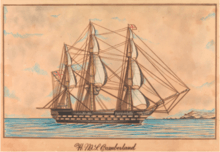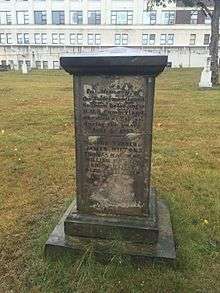HMS Cumberland (1842)
For other ships with the same name, see HMS Cumberland.
 H.M.S. Cumberland, c.1852 | |
| History | |
|---|---|
| Name: | HMS Cumberland |
| Builder: | Chatham Dockyard |
| Laid down: | April 1836 |
| Launched: | 21 October 1842 |
| Fate: | Burnt, 1889 |
| General characteristics [1] | |
| Class and type: | 70-gun third rate ship of the line |
| Tons burthen: | 2214 bm |
| Length: | 180 ft (55 m) (gundeck) |
| Beam: | 54 ft 3 in (16.54 m) |
| Depth of hold: | 22 ft 4 in (6.81 m) |
| Propulsion: | Sails |
| Sail plan: | Full rigged ship |
| Armament: |
|
HMS Cumberland was a 70-gun third rate ship of the line of the Royal Navy, launched on 21 October 1842 at Chatham Dockyard.[1] She carried a crew of 620 men. 'Cumberland' recommissioned as a flagship under Captain George Henry Seymour as the flagship of his father, Vice Admiral Sir George Francis Seymour. She served in North America, the West Indies.[2] In March 1854 she sailed to the Baltic Sea as war with Russia was imminent (the Crimean War). Cumberland was involved in the attack on Bomarsund, Finland in August of that year.[3] She was converted to serve as a training ship in 1870. Cumberland was destroyed by fire in 1889.[1]

Monument to the 6 crew of HMS Cumberland that died at Halifax, Royal Navy Burying Ground (Halifax, Nova Scotia)
Notes
- 1 2 3 Lavery, Ships of the Line vol. 1, p. 192.
- ↑ Maritime Museum, Greenwich, London
- ↑ http://www.royalnavy.mod.uk/operations-and-support/surface-fleet/type-22-frigates/hms-cumberland/history/
References
- Lavery, Brian (2003) The Ship of the Line - Volume 1: The development of the battlefleet 1650-1850. Conway Maritime Press. ISBN 0-85177-252-8.
This article is issued from Wikipedia - version of the 9/20/2016. The text is available under the Creative Commons Attribution/Share Alike but additional terms may apply for the media files.